THE WOMAN IN WHITE
JOANNA HIFFERNAN and JAMES McNEILL WHISTLER
NATIONAL GALLERY OF ART, Washington
July 3 – October 10, 2022

Together forever
She was his main model and he portrayed her
in three paintings that became a myth in Art: The Woman in White
She, in Symphony in White, No.1
The White Girl
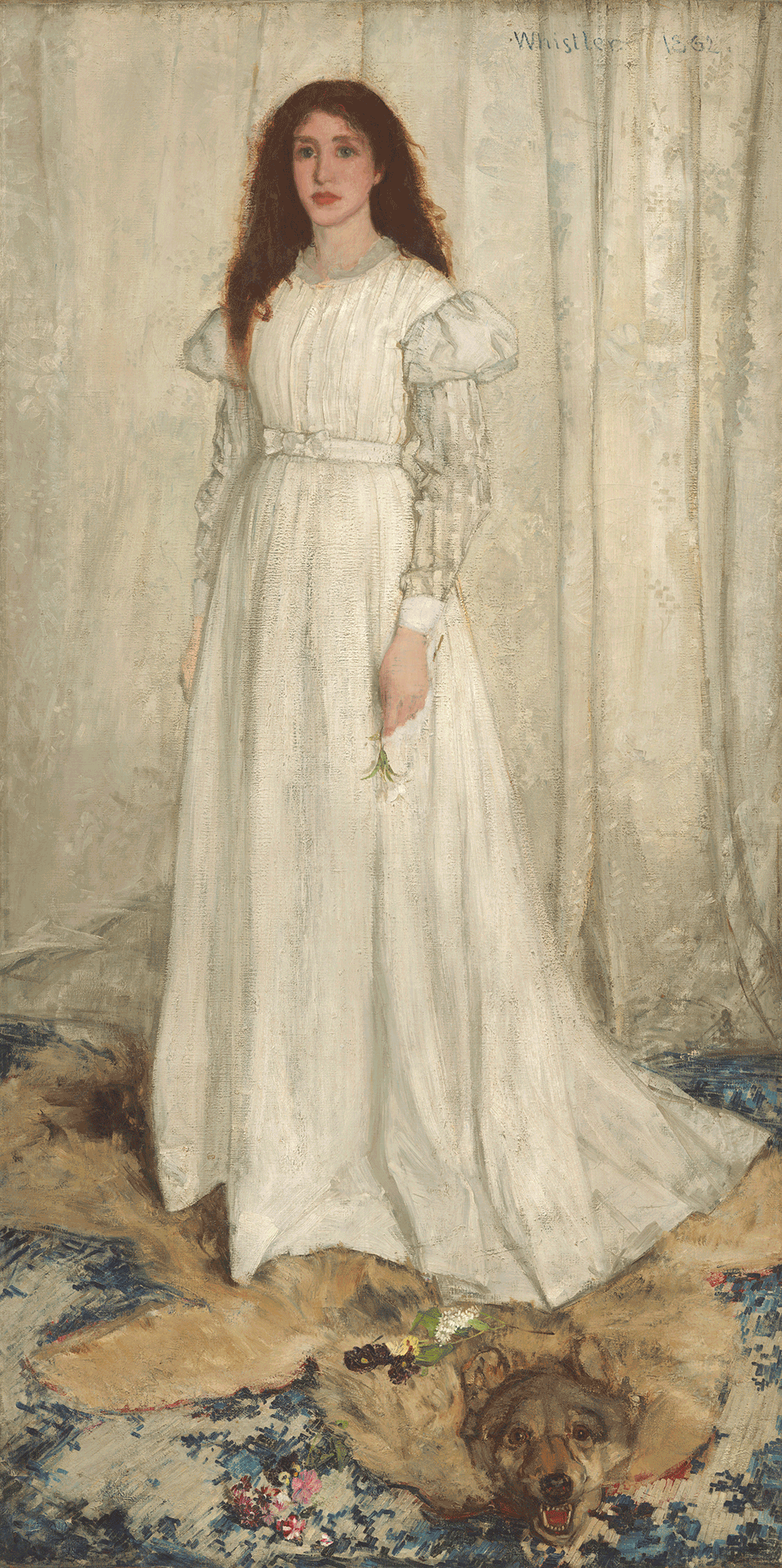 James McNeill Whistler. Symphony in White, No. 1: The White Girl, 1861–1863, 1872, oil on canvas, overall: 213 x 107.9 cm (83 7/8 x 42 1/2 in.), framed: 244.2 x 136.5 x 8.3 cm (96 1/8 x 53 3/4 x 3 1/4 in.)overall: 213 x 107.9 cm (83 7/8 x 42 1/2 in.) framed: 244.2 x 136.5 x 8.3 cm (96 1/8 x 53 3/4 x 3 1/4 in.) National Gallery of Art, Washington, Harris Whittemore Collection
James McNeill Whistler. Symphony in White, No. 1: The White Girl, 1861–1863, 1872, oil on canvas, overall: 213 x 107.9 cm (83 7/8 x 42 1/2 in.), framed: 244.2 x 136.5 x 8.3 cm (96 1/8 x 53 3/4 x 3 1/4 in.)overall: 213 x 107.9 cm (83 7/8 x 42 1/2 in.) framed: 244.2 x 136.5 x 8.3 cm (96 1/8 x 53 3/4 x 3 1/4 in.) National Gallery of Art, Washington, Harris Whittemore Collection
She, in Symphony in White, No. 2
The Little White Girl
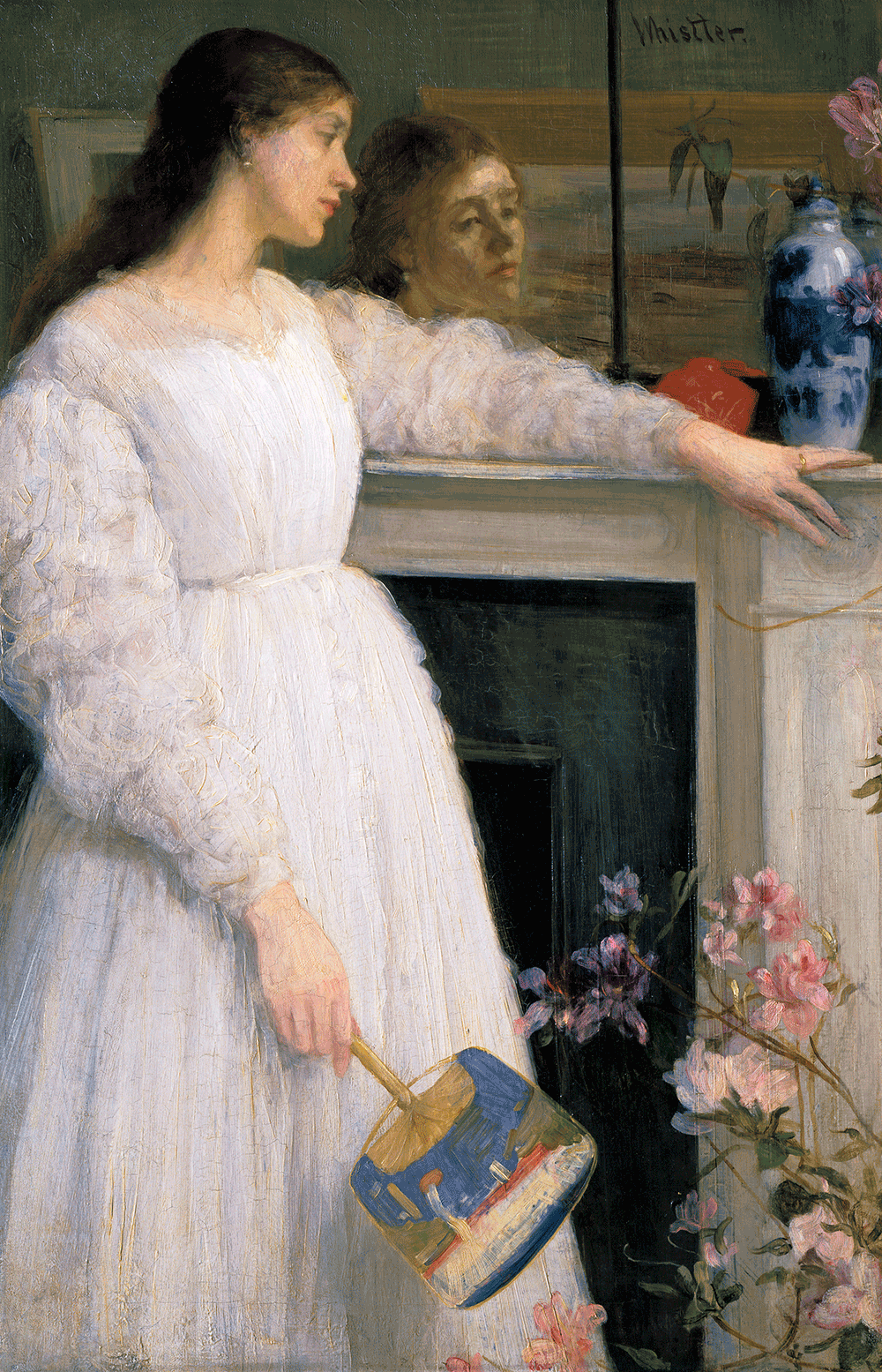
James McNeill Whistler. Symphony in White, No. 2: The Little White Girl, 1864, oil on canvas, overall: 76.5 x 51.1 cm (30 1/8 x 20 1/8 in.), framed: 108.5 x 83 x 11.8 cm (42 11/16 x 32 11/16 x 4 5/8 in.)overall: 76.5 x 51.1 cm (30 1/8 x 20 1/8 in.),framed: 108.5 x 83 x 11.8 cm (42 11/16 x 32 11/16 x 4 5/8 in.) Tate, London, Bequeathed by Arthur Studd 1919 © Tate, London 2017
She, in Symphony in White, No. 3
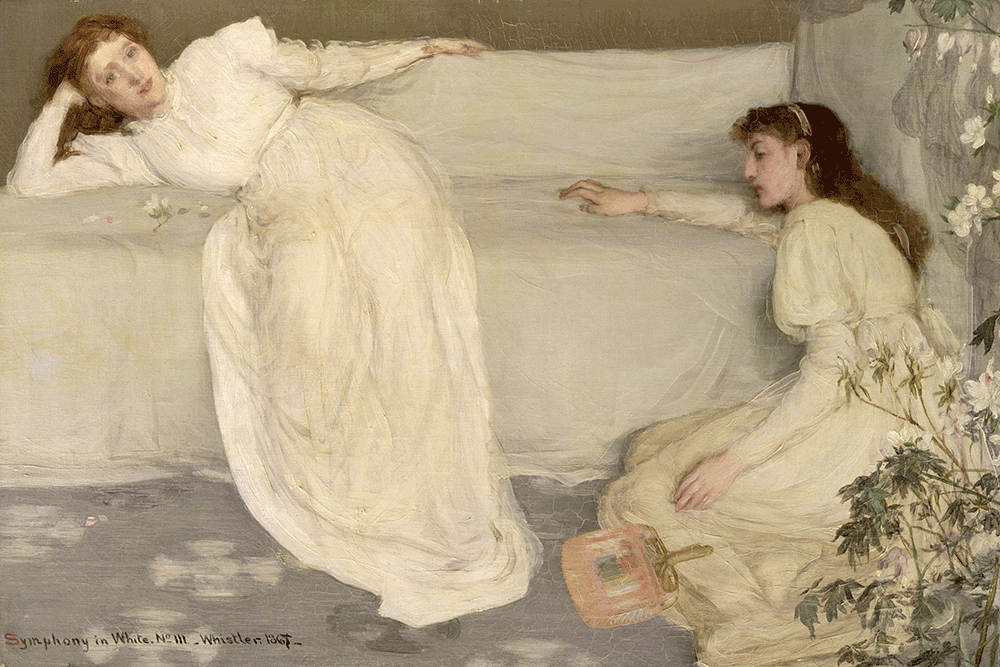 James McNeill Whistler. Symphony in White, No. 3, 1865–1867, oil on canvas, overall: 51 x 76.5 cm (20 1/16 x 30 1/8 in.), framed: 86 x 112 x 6.7 cm (33 7/8 x 44 1/8 x 2 5/8 in.)overall: 51 x 76.5 cm (20 1/16 x 30 1/8 in.), framed: 86 x 112 x 6.7 cm (33 7/8 x 44 1/8 x 2 5/8 in.) The Henry Barber Trust, The Barber Institute of Fine Arts, University of Birmingham. Bridgeman Images
James McNeill Whistler. Symphony in White, No. 3, 1865–1867, oil on canvas, overall: 51 x 76.5 cm (20 1/16 x 30 1/8 in.), framed: 86 x 112 x 6.7 cm (33 7/8 x 44 1/8 x 2 5/8 in.)overall: 51 x 76.5 cm (20 1/16 x 30 1/8 in.), framed: 86 x 112 x 6.7 cm (33 7/8 x 44 1/8 x 2 5/8 in.) The Henry Barber Trust, The Barber Institute of Fine Arts, University of Birmingham. Bridgeman Images
Who was She?
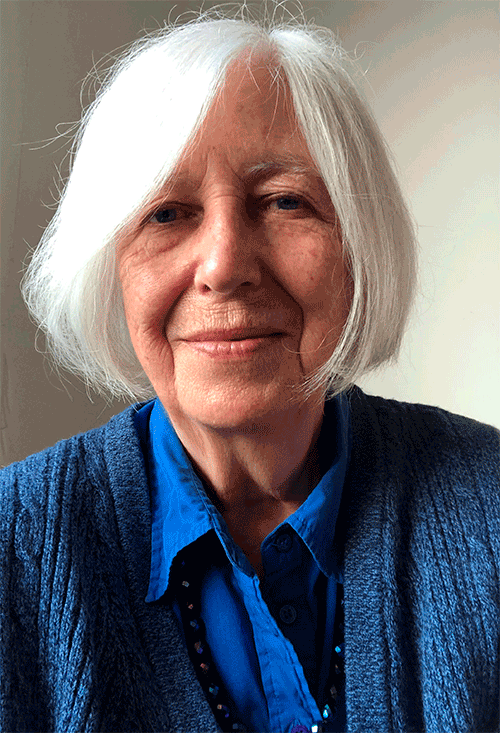 Margaret F. MacDonald, curator of the exhibition and professor of art history in the School of Culture and Creative Arts at the University of Glasgow explores in this exhibition the life of Joanna Hiffernan and her influential role in the life and work of artist James McNeil Whistler. This exhibition represents the first concerted effort to better explain what is hidden from view in many of Whistler’s celebrated early works: Hiffernan herself.
Margaret F. MacDonald, curator of the exhibition and professor of art history in the School of Culture and Creative Arts at the University of Glasgow explores in this exhibition the life of Joanna Hiffernan and her influential role in the life and work of artist James McNeil Whistler. This exhibition represents the first concerted effort to better explain what is hidden from view in many of Whistler’s celebrated early works: Hiffernan herself.
Joanna Hiffernan, an Irish immigrant to London, played a critical role in the art and life of American expatriate artist James McNeill Whistler. During the early 1860s she worked closely with Whistler, primarily as a model, on innovative paintings, prints, and drawings that challenged prevailing cultural norms and established Whistler’s reputation as one of the most influential artists of the late 19th century.
Baptized in Ireland in 1839, she migrated with her family to London by June 1843. She met Whistler in 1860 and within a year became the artist’s chief model. Romantically partnered with Whistler for five years, Hiffernan helped to manage his studio even after their relationship ended. Later, with her sister Agnes, Hiffernan raised a child, Charlie Hanson, who Whistler fathered with another woman. Hiffernan remained an integral part of Whistler’s life until her death in 1886 at the age of 46.
Daily life as a couple
Operating on the margins of London society, Whistler and Hiffernan gravitated to the crowded, working-class district of Wapping on the banks of the polluted River Thames. They frequented the Angel Inn, a pub that became the setting for the painting Wapping (1860–1864). At the center, amid the gritty details of life along the river, a woman—modeled by Hiffernan—presides over the scene. Her pose and dress (including a neckline that may have been slightly risqué for audiences at the time) suggest she represents one of the thousands of women in London who earned incomes by engaging in sex work.
Wapping
In this work, Hiffernan acted as a model. She can be identified by her red hair
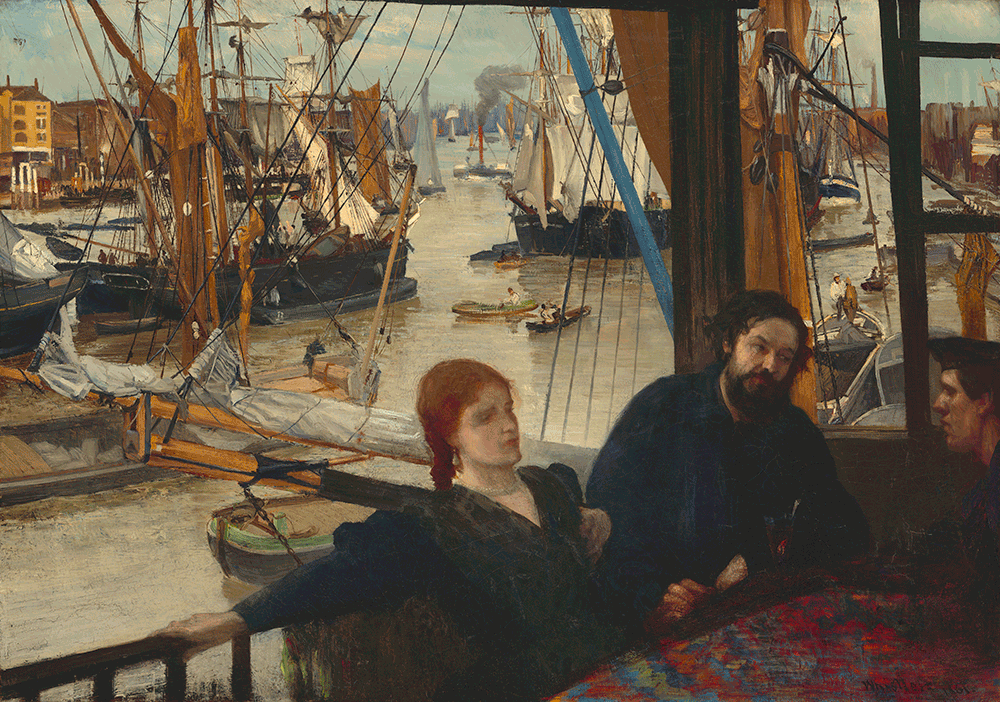 James McNeill Whistler. Wapping, 1860–1864, oil on canvas, overall: 72 x 101.8 cm (28 3/8 x 40 1/16 in.) framed: 92.1 x 123.5 x 7.6 cm (36 1/4 x 48 5/8 x 3 in.)overall: 72 x 101.8 cm (28 3/8 x 40 1/16 in.) framed: 92.1 x 123.5 x 7.6 cm (36 1/4 x 48 5/8 x 3 in.) National Gallery of Art, Washington, John Hay Whitney Collection
James McNeill Whistler. Wapping, 1860–1864, oil on canvas, overall: 72 x 101.8 cm (28 3/8 x 40 1/16 in.) framed: 92.1 x 123.5 x 7.6 cm (36 1/4 x 48 5/8 x 3 in.)overall: 72 x 101.8 cm (28 3/8 x 40 1/16 in.) framed: 92.1 x 123.5 x 7.6 cm (36 1/4 x 48 5/8 x 3 in.) National Gallery of Art, Washington, John Hay Whitney Collection
Two details of the painting Wapping
In this work Whistler shows his great ability to create for the viewer an immersive state in a subject where the stories told by the background of the painting are very important to represent the moment with an overwhelming sense of reality. Whistler masterfully depicts that there is intense activity in the background of the painting.

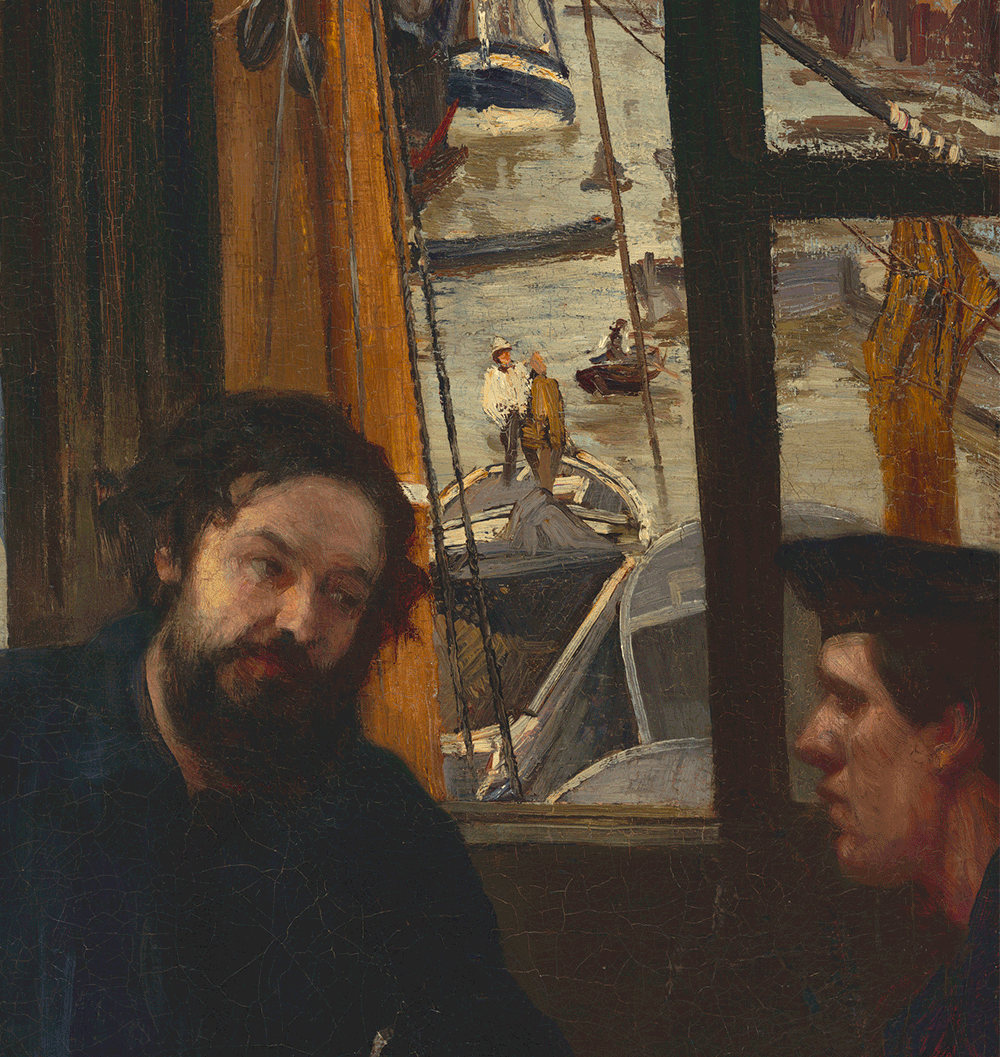
Whistler, the Ports and the Water
Whistler was a master at depicting subjects that are related to water. Would she like it as much as he did? surely she would.
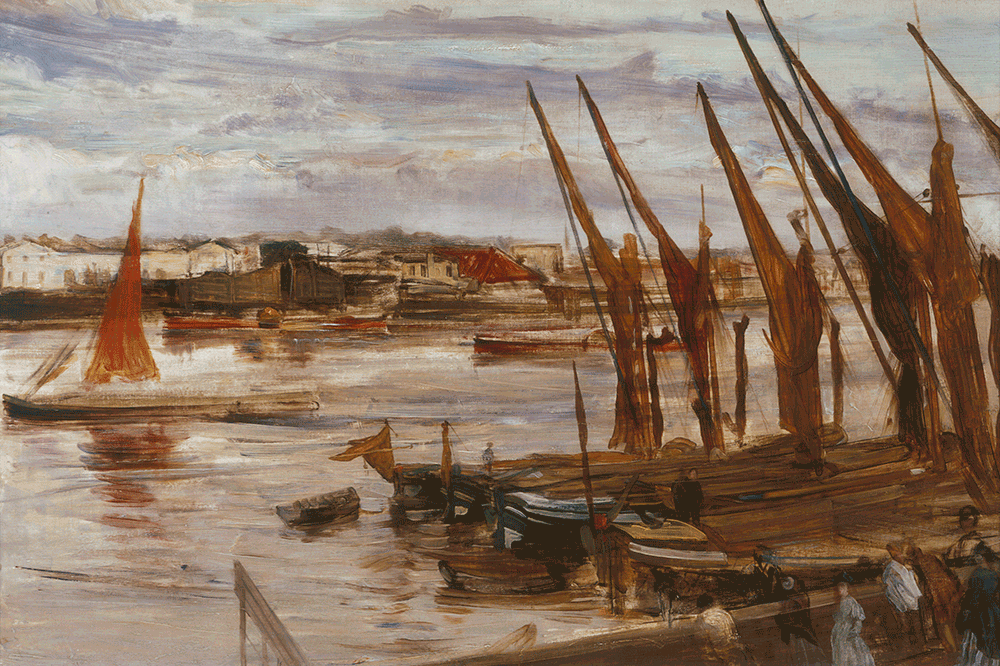 James McNeill Whistler. Battersea Reach, 1862/1863, oil on canvas, overall: 50.8 x 76.4 cm (20 x 30 1/16 in.) framed: 70.49 x 95.89 x 7.62 cm (27 3/4 x 37 3/4 x 3 in.)overall: 50.8 x 76.4 cm (20 x 30 1/16 in.) framed: 70.49 x 95.89 x 7.62 cm (27 3/4 x 37 3/4 x 3 in.) National Gallery of Art, Washington, Corcoran Collection (Bequest of James Parmelee; Frame restored in memory of Anne Wallick and Marianna Grove, members of the Women’s Committee of the Corcoran Gallery of Art)
James McNeill Whistler. Battersea Reach, 1862/1863, oil on canvas, overall: 50.8 x 76.4 cm (20 x 30 1/16 in.) framed: 70.49 x 95.89 x 7.62 cm (27 3/4 x 37 3/4 x 3 in.)overall: 50.8 x 76.4 cm (20 x 30 1/16 in.) framed: 70.49 x 95.89 x 7.62 cm (27 3/4 x 37 3/4 x 3 in.) National Gallery of Art, Washington, Corcoran Collection (Bequest of James Parmelee; Frame restored in memory of Anne Wallick and Marianna Grove, members of the Women’s Committee of the Corcoran Gallery of Art)
Detail of Battersea Reach
Another masterful detail of how Whistler manages with a few brief, gestural brushstrokes to make us see how the water flows and swirls at the edge of the pier.

Rotherhithe, 1860
 James McNeill Whistler. Rotherhithe, 1860, etching and drypoint on ivory laid paper sheet (trimmed to plate mark): 27.6 x 20.1 cm (10 7/8 x 7 15/16 in.)sheet (trimmed to plate mark): 27.6 x 20.1 cm (10 7/8 x 7 15/16 in.) National Gallery of Art, Washington, Gift of John Nichols Estabrook and Dorothy Coogan Estabrook
James McNeill Whistler. Rotherhithe, 1860, etching and drypoint on ivory laid paper sheet (trimmed to plate mark): 27.6 x 20.1 cm (10 7/8 x 7 15/16 in.)sheet (trimmed to plate mark): 27.6 x 20.1 cm (10 7/8 x 7 15/16 in.) National Gallery of Art, Washington, Gift of John Nichols Estabrook and Dorothy Coogan Estabrook
Hiffernan in Print
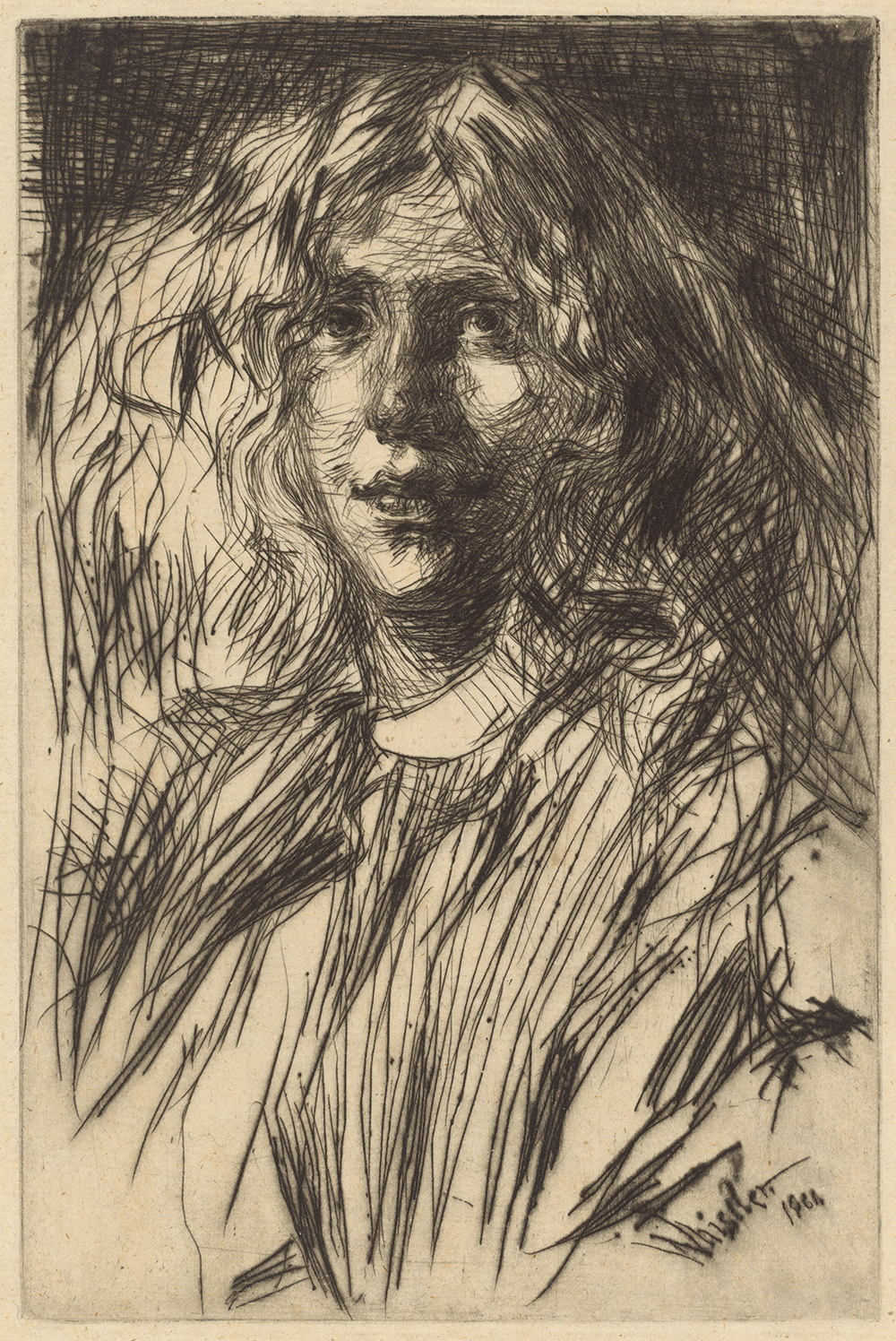 James McNeill Whistler. Jo, 1861, drypoint on ivory laid paper, sheet: 45.1 x 31.1 cm (17 3/4 x 12 1/4 in.)plate: 22.9 x 15.2 cm (9 x 6 in.)sheet: 45.1 x 31.1 cm (17 3/4 x 12 1/4 in.) plate: 22.9 x 15.2 cm (9 x 6 in.) National Gallery of Art, Washington, Rosenwald Collection
James McNeill Whistler. Jo, 1861, drypoint on ivory laid paper, sheet: 45.1 x 31.1 cm (17 3/4 x 12 1/4 in.)plate: 22.9 x 15.2 cm (9 x 6 in.)sheet: 45.1 x 31.1 cm (17 3/4 x 12 1/4 in.) plate: 22.9 x 15.2 cm (9 x 6 in.) National Gallery of Art, Washington, Rosenwald Collection
In addition to paintings, Hiffernan posed for many of Whistler’s smaller, more intimate prints. In Weary, the dense weave of black marks that constitute her hair and torso give way to the spare, open white spaces of the skirt below. The shift from black to white, and from realism to abstraction, mirrors the transition between waking and sleeping. Whistler rendered Weary in six different states and numerous impressions, as artist and model explored subtle gradations of consciousness.
Weary
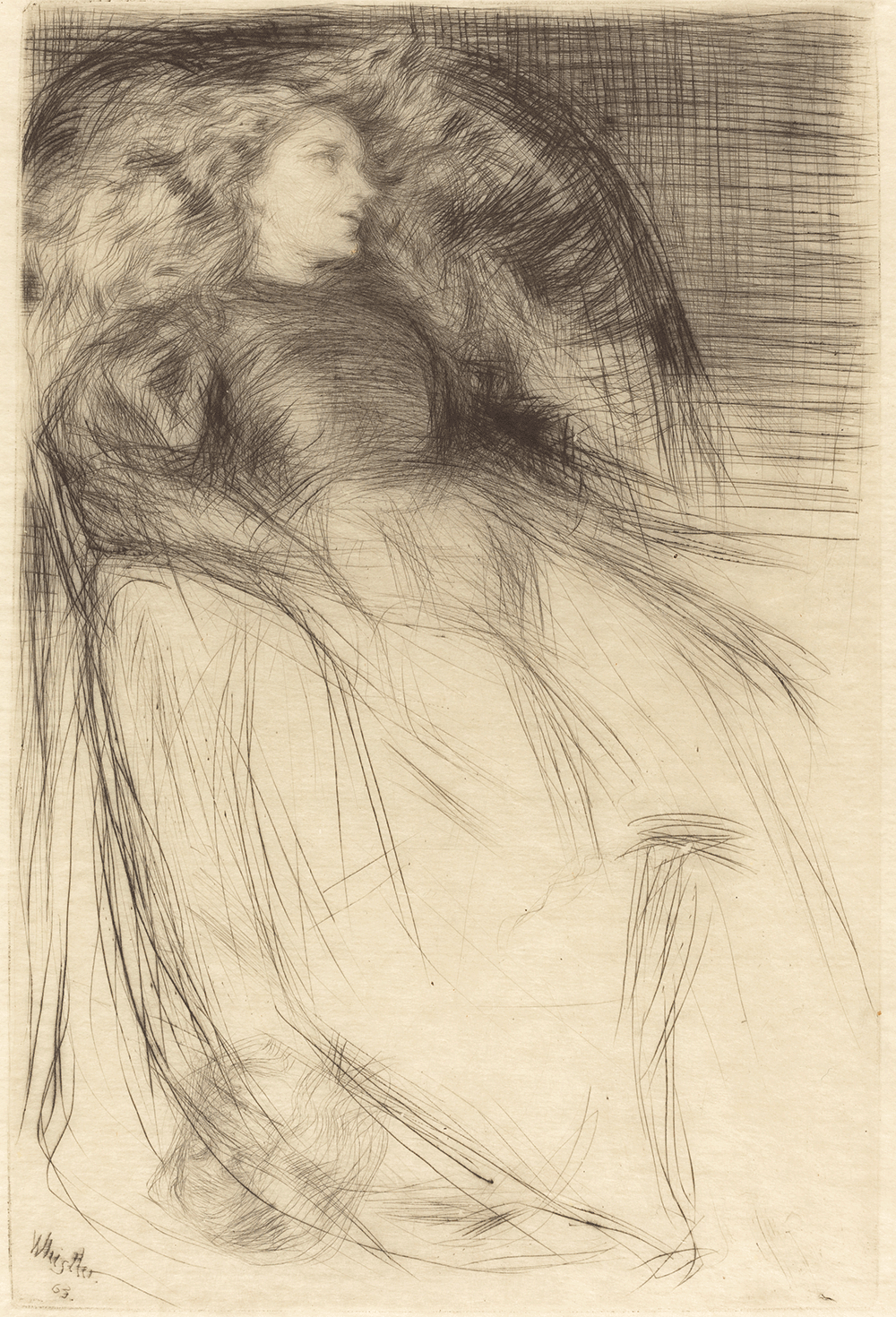 James McNeill Whistler. Weary, 1863, drypoint on cream Japan paper, plate: 19.7 x 13.1 cm (7 3/4 x 5 3/16 in.) sheet: 34.5 x 23.5 cm (13 9/16 x 9 1/4 in.) framed: 60 x 44.7 x 2.5 cm (23 5/8 x 17 5/8 x 1 in.)plate: 19.7 x 13.1 cm (7 3/4 x 5 3/16 in.) sheet: 34.5 x 23.5 cm (13 9/16 x 9 1/4 in.) framed: 60 x 44.7 x 2.5 cm (23 5/8 x 17 5/8 x 1 in.) The Syndics of the Fitzwilliam Museum, University of Cambridge © The Fitzwilliam Museum, Cambridge
James McNeill Whistler. Weary, 1863, drypoint on cream Japan paper, plate: 19.7 x 13.1 cm (7 3/4 x 5 3/16 in.) sheet: 34.5 x 23.5 cm (13 9/16 x 9 1/4 in.) framed: 60 x 44.7 x 2.5 cm (23 5/8 x 17 5/8 x 1 in.)plate: 19.7 x 13.1 cm (7 3/4 x 5 3/16 in.) sheet: 34.5 x 23.5 cm (13 9/16 x 9 1/4 in.) framed: 60 x 44.7 x 2.5 cm (23 5/8 x 17 5/8 x 1 in.) The Syndics of the Fitzwilliam Museum, University of Cambridge © The Fitzwilliam Museum, Cambridge
Jo’s Bent Head, 1861
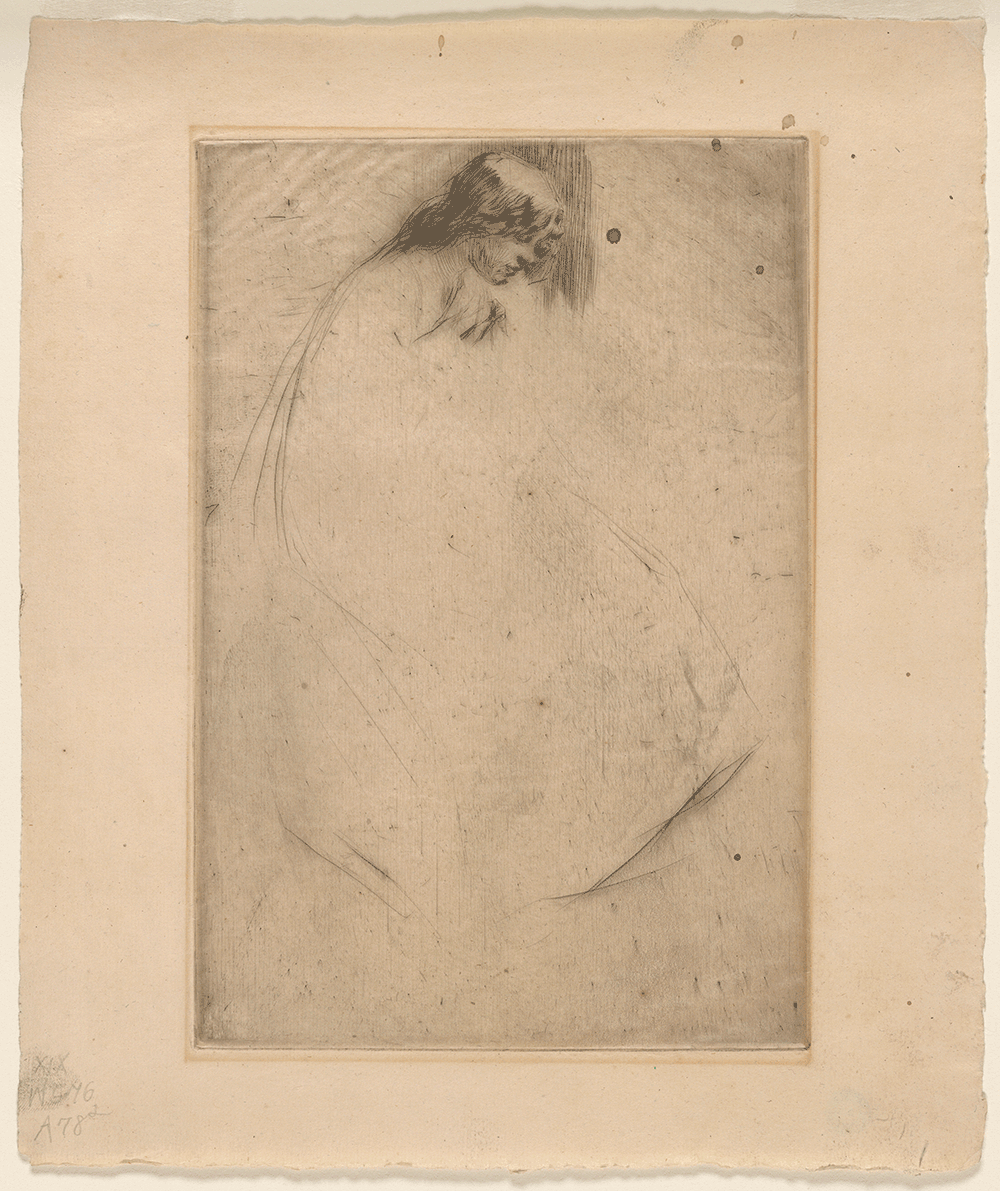 James McNeill Whistler. Jo’s Bent Head, 1861, drypoint on tan laid paper, image: 22.4 x 15.6 cm (8 13/16 x 6 1/8 in.) sheet: 28.1 x 23.7 cm (11 1/16 x 9 5/16 in.) framed: 39 x 31.4 cm (15 3/8 x 12 3/8 in.)image: 22.4 x 15.6 cm (8 13/16 x 6 1/8 in.) sheet: 28.1 x 23.7 cm (11 1/16 x 9 5/16 in.) framed: 39 x 31.4 cm (15 3/8 x 12 3/8 in.) Prints and Photographs Division, Library of Congress, Washington, DC
James McNeill Whistler. Jo’s Bent Head, 1861, drypoint on tan laid paper, image: 22.4 x 15.6 cm (8 13/16 x 6 1/8 in.) sheet: 28.1 x 23.7 cm (11 1/16 x 9 5/16 in.) framed: 39 x 31.4 cm (15 3/8 x 12 3/8 in.)image: 22.4 x 15.6 cm (8 13/16 x 6 1/8 in.) sheet: 28.1 x 23.7 cm (11 1/16 x 9 5/16 in.) framed: 39 x 31.4 cm (15 3/8 x 12 3/8 in.) Prints and Photographs Division, Library of Congress, Washington, DC
Detail of Jo’s Bent Head
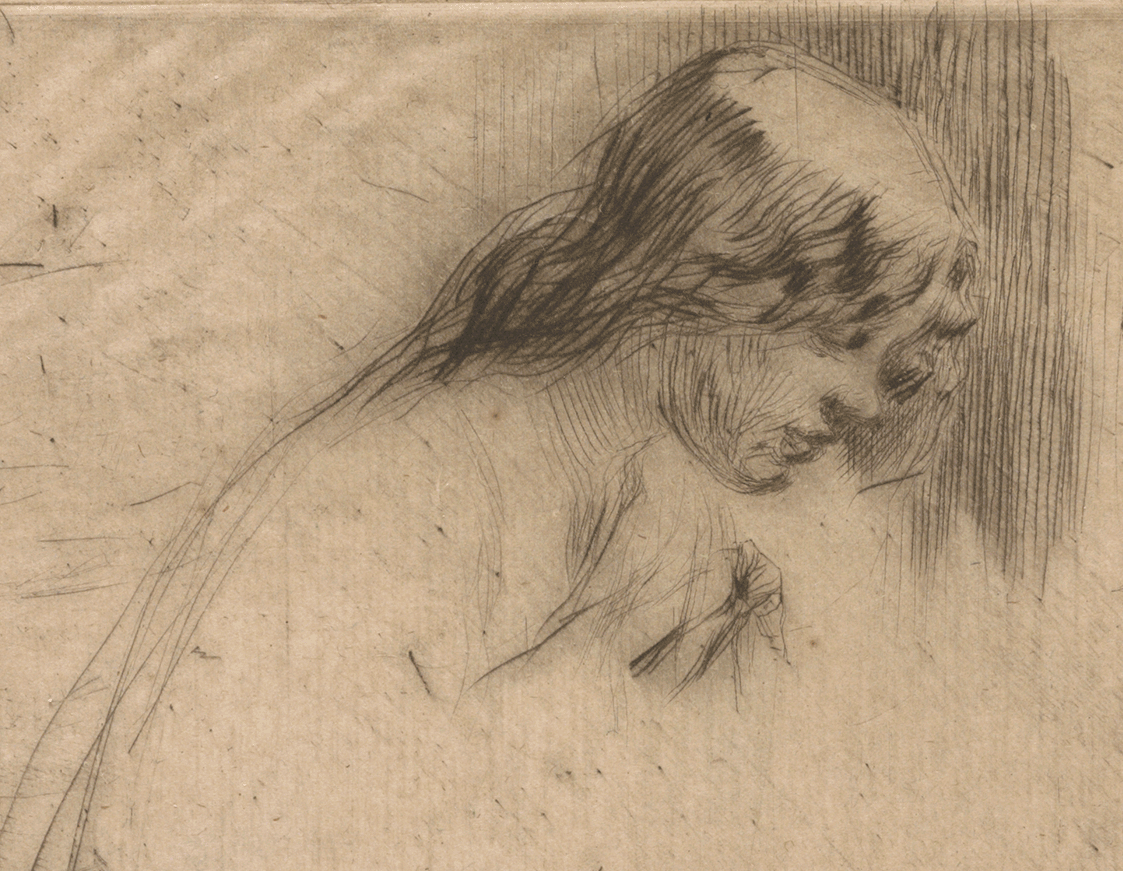
Whistler: drypoint master
In addition to the portraits of Hiffernan in which she is reflected
with exquisite beauty, the exhibition also presents other masterpieces
made with the very difficult technique of drypoint.
Brushing the Hair
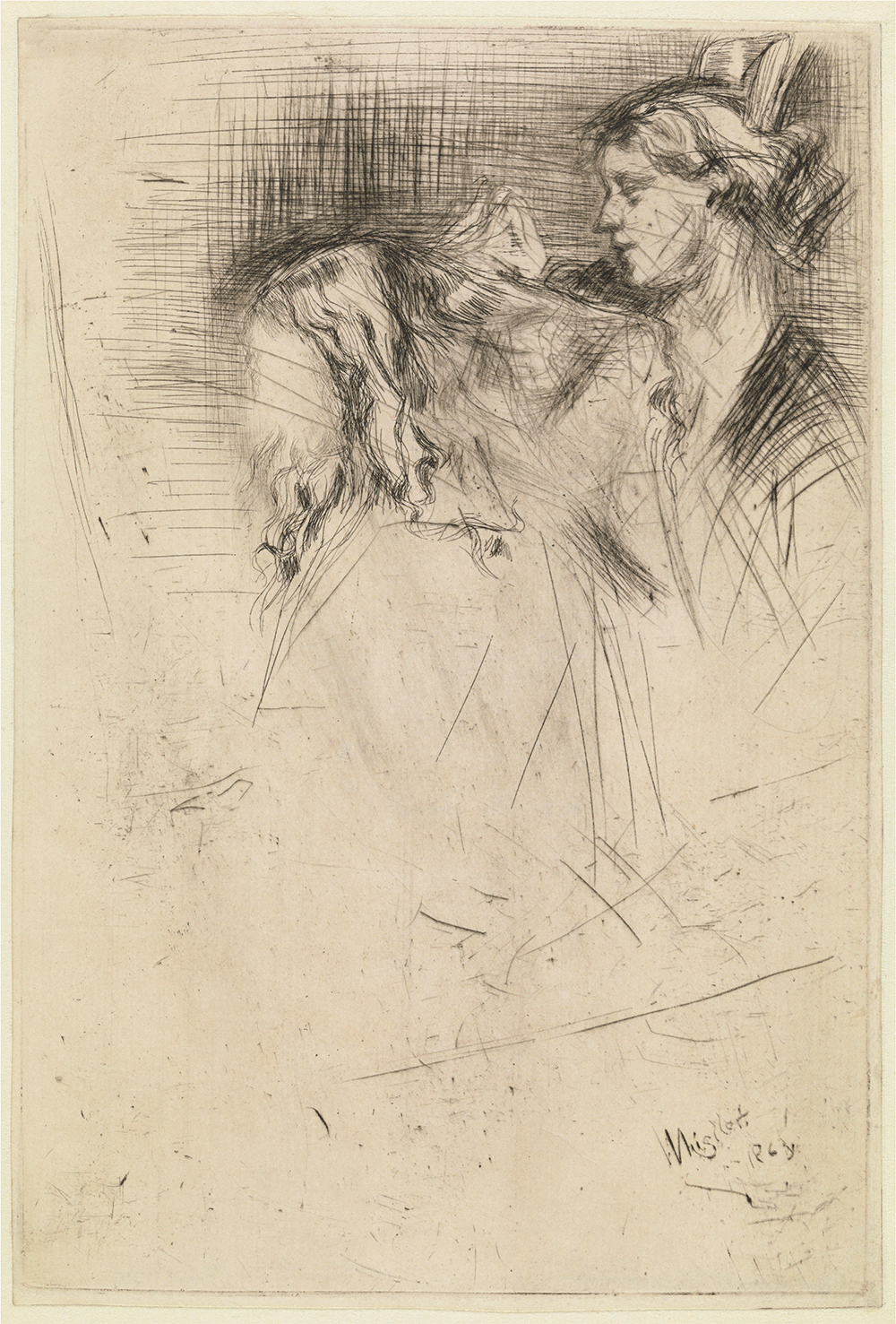 James McNeill Whistler. Brushing the Hair, 1863, canceled and printed 1879, drypoint on ivory laid paper plate: 22.7 x 15.2 cm (8 15/16 x 6 in.) sheet: 23.2 x 15.7 cm (9 1/8 x 6 3/16 in.) mount: 55.8 x 40.6 cm (21 15/16 x 16 in.) framed (provisional): 59 x 43.7 x 2.2 cm (23 1/4 x 17 3/16 x 7/8 in.)plate: 22.7 x 15.2 cm (8 15/16 x 6 in.) sheet: 23.2 x 15.7 cm (9 1/8 x 6 3/16 in.) mount: 55.8 x 40.6 cm (21 15/16 x 16 in.) framed (provisional): 59 x 43.7 x 2.2 cm (23 1/4 x 17 3/16 x 7/8 in.) The Hunterian, University of Glasgow
James McNeill Whistler. Brushing the Hair, 1863, canceled and printed 1879, drypoint on ivory laid paper plate: 22.7 x 15.2 cm (8 15/16 x 6 in.) sheet: 23.2 x 15.7 cm (9 1/8 x 6 3/16 in.) mount: 55.8 x 40.6 cm (21 15/16 x 16 in.) framed (provisional): 59 x 43.7 x 2.2 cm (23 1/4 x 17 3/16 x 7/8 in.)plate: 22.7 x 15.2 cm (8 15/16 x 6 in.) sheet: 23.2 x 15.7 cm (9 1/8 x 6 3/16 in.) mount: 55.8 x 40.6 cm (21 15/16 x 16 in.) framed (provisional): 59 x 43.7 x 2.2 cm (23 1/4 x 17 3/16 x 7/8 in.) The Hunterian, University of Glasgow
Whistler’s chalk and charcoal technique
Drawing with chalk and charcoal was another painting technique
that Whistler dominated, for which he masterfully used
the chiaroscuro that these unique drawing materials allowed him.
Sleeping Woman
 James McNeill Whistler. Sleeping Woman, 1863, chalk and charcoal on cream wove paper mounted on paperboard sheet (irregular bottom edge): 25 x 17.6 cm (9 13/16 x 6 15/16 in.) mount: 35.9 x 27.8 cm (14 1/8 x 10 15/16 in.)sheet (irregular bottom edge): 25 x 17.6 cm (9 13/16 x 6 15/16 in.) mount: 35.9 x 27.8 cm (14 1/8 x 10 15/16 in.) National Gallery of Art, Washington, Rosenwald Collection
James McNeill Whistler. Sleeping Woman, 1863, chalk and charcoal on cream wove paper mounted on paperboard sheet (irregular bottom edge): 25 x 17.6 cm (9 13/16 x 6 15/16 in.) mount: 35.9 x 27.8 cm (14 1/8 x 10 15/16 in.)sheet (irregular bottom edge): 25 x 17.6 cm (9 13/16 x 6 15/16 in.) mount: 35.9 x 27.8 cm (14 1/8 x 10 15/16 in.) National Gallery of Art, Washington, Rosenwald Collection
Detail of Sleeping Woman
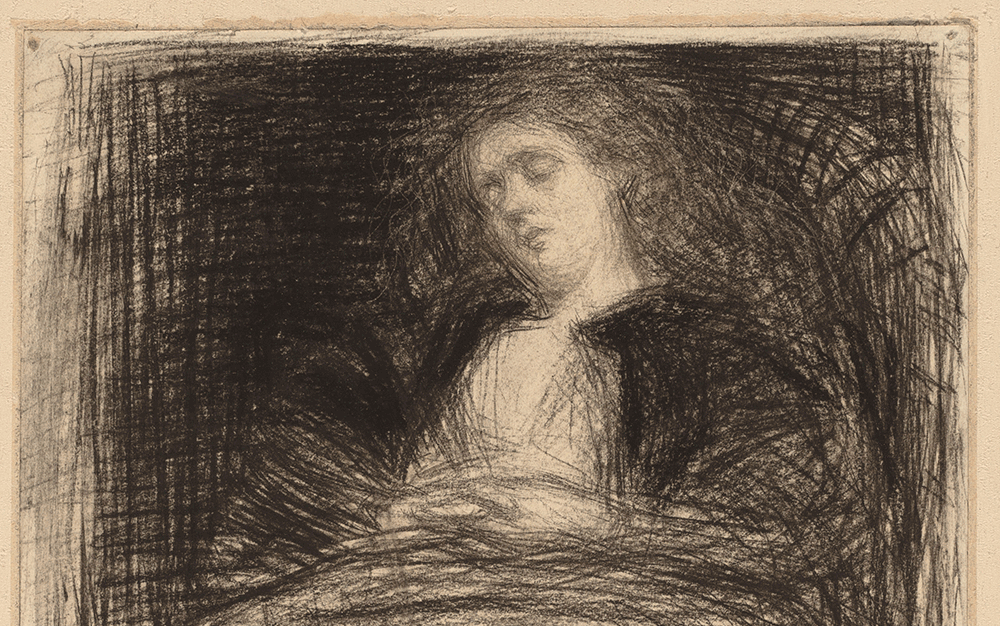
The Sleeper
 James McNeill Whistler. The Sleeper, 1863, chalk on white wove paper laid down, overall: 24.5 x 17.5 cm (9 5/8 x 6 7/8 in.) framed (provisional): 55.88 x 40.64 cm (22 x 16 in.)overall: 24.5 x 17.5 cm (9 5/8 x 6 7/8 in.) framed (provisional): 55.88 x 40.64 cm (22 x 16 in.) Sterling and Francine Clark Art Institute, Williamstown, Massachusetts Image courtesy Clark Art Institute. clarkart.edu
James McNeill Whistler. The Sleeper, 1863, chalk on white wove paper laid down, overall: 24.5 x 17.5 cm (9 5/8 x 6 7/8 in.) framed (provisional): 55.88 x 40.64 cm (22 x 16 in.)overall: 24.5 x 17.5 cm (9 5/8 x 6 7/8 in.) framed (provisional): 55.88 x 40.64 cm (22 x 16 in.) Sterling and Francine Clark Art Institute, Williamstown, Massachusetts Image courtesy Clark Art Institute. clarkart.edu
The Artist in His Studio
(Whistler in His Studio)
It is the last painting in which Hiffernan appears (the figure in white),
although it does not mark the end of their relationship.
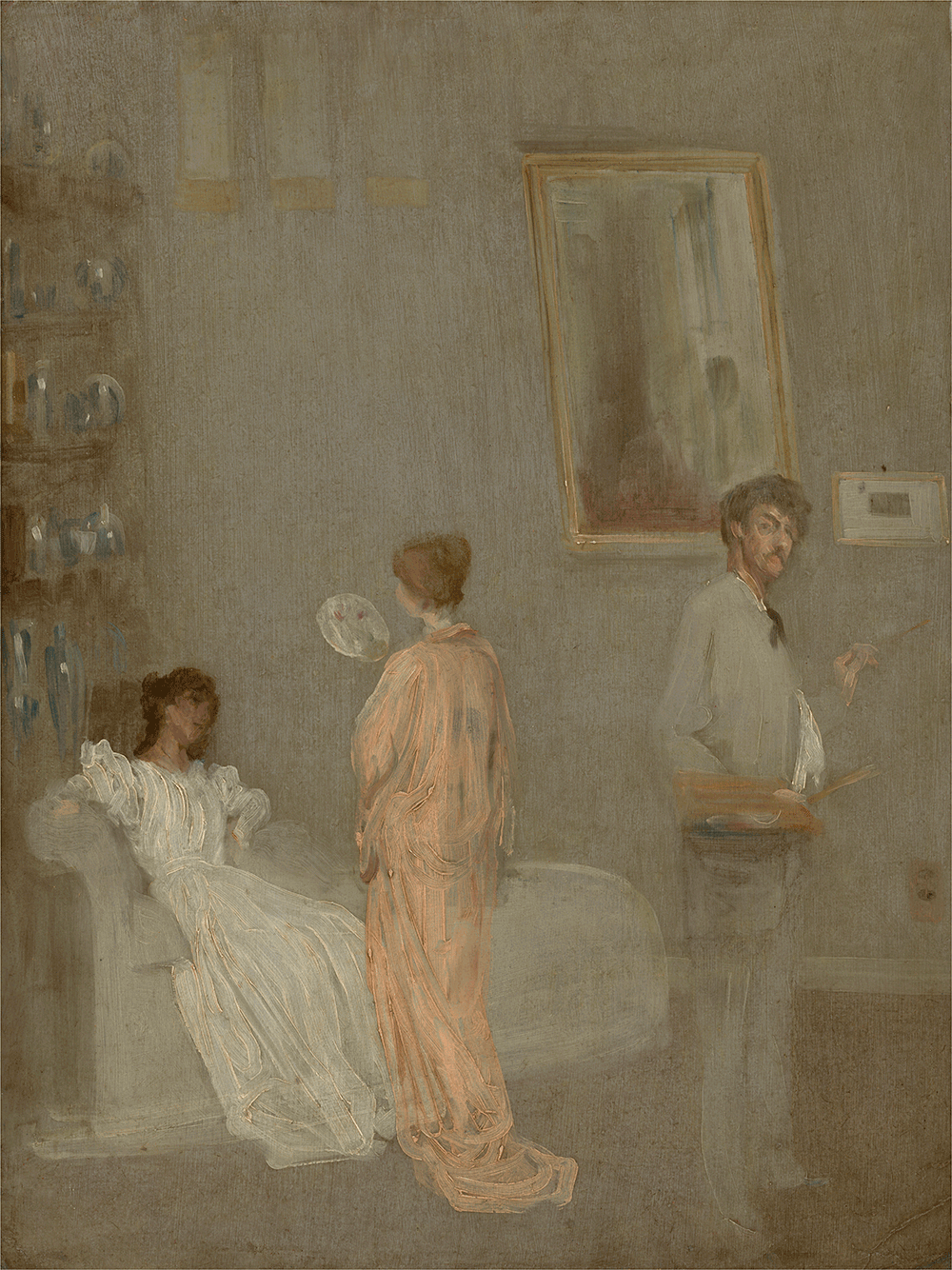 James McNeill Whistler. The Artist in His Studio (Whistler in His Studio), 1865/1872, 1895, oil on paper mounted on panel, overall: 63 x 47.3 cm (24 13/16 x 18 5/8 in.) framed: 86.7 x 71.1 cm (34 1/8 x 28 in.)overall: 63 x 47.3 cm (24 13/16 x 18 5/8 in.) framed: 86.7 x 71.1 cm (34 1/8 x 28 in.) The Art Institute of Chicago, Friends of American Art Collection, 1912.141 The Art Institute of Chicago / Art Resource, NY
James McNeill Whistler. The Artist in His Studio (Whistler in His Studio), 1865/1872, 1895, oil on paper mounted on panel, overall: 63 x 47.3 cm (24 13/16 x 18 5/8 in.) framed: 86.7 x 71.1 cm (34 1/8 x 28 in.)overall: 63 x 47.3 cm (24 13/16 x 18 5/8 in.) framed: 86.7 x 71.1 cm (34 1/8 x 28 in.) The Art Institute of Chicago, Friends of American Art Collection, 1912.141 The Art Institute of Chicago / Art Resource, NY
Purple and Rose:
The Lange Leizen of the Six Marks
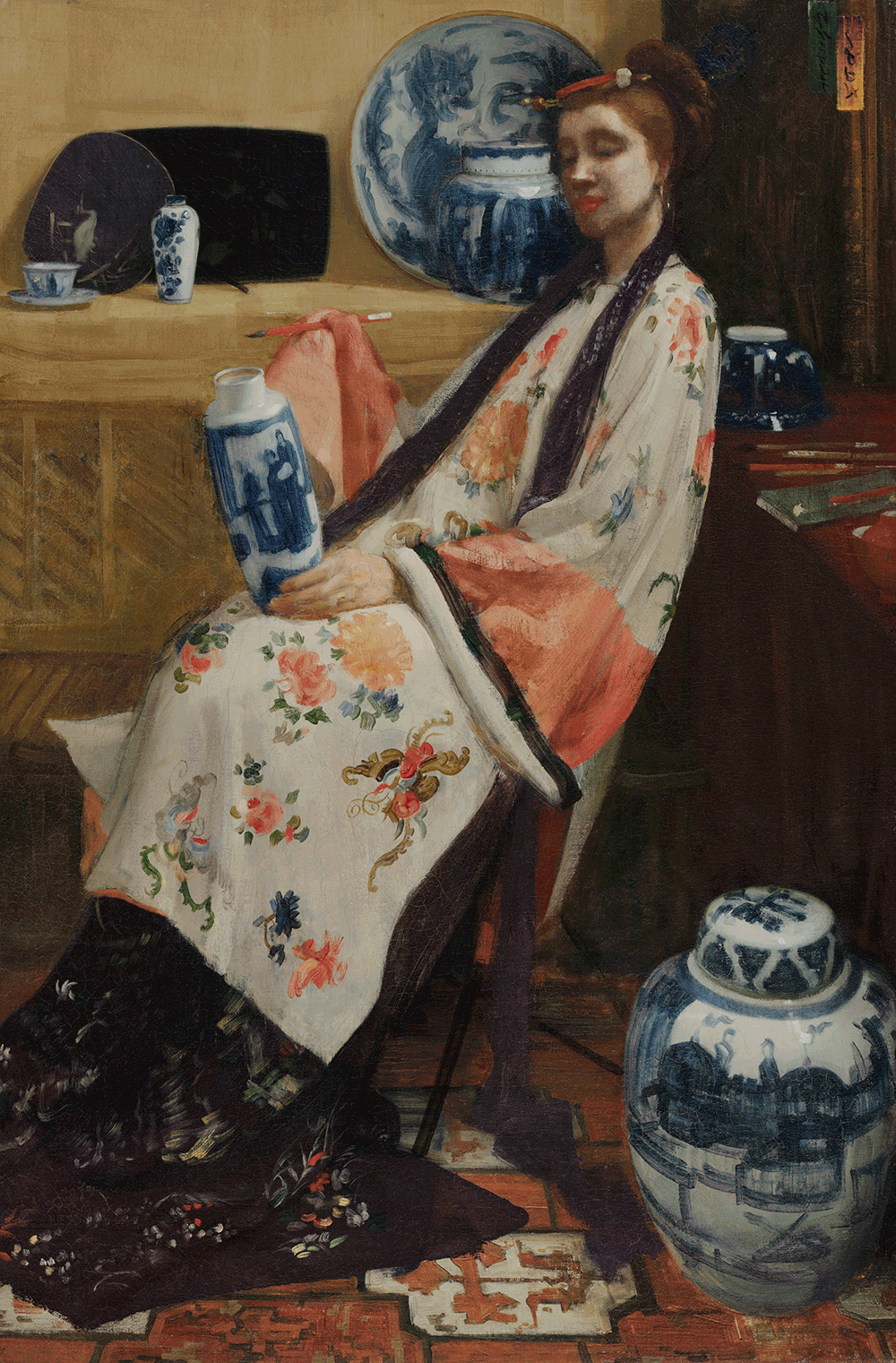 James McNeill Whistler. Purple and Rose: The Lange Leizen of the Six Marks, 1864, oil on canvas, overall: 92 x 61.5 cm (36 1/4 x 24 3/16 in.) framed: 123.2 x 86.7 x 7.6 cm (48 1/2 x 34 1/8 x 3 in.)overall: 92 x 61.5 cm (36 1/4 x 24 3/16 in.) framed: 123.2 x 86.7 x 7.6 cm (48 1/2 x 34 1/8 x 3 in.) Philadelphia Museum of Art, John G. Johnson Collection, 1917. Courtesy of the Philadelphia Museum of Art
James McNeill Whistler. Purple and Rose: The Lange Leizen of the Six Marks, 1864, oil on canvas, overall: 92 x 61.5 cm (36 1/4 x 24 3/16 in.) framed: 123.2 x 86.7 x 7.6 cm (48 1/2 x 34 1/8 x 3 in.)overall: 92 x 61.5 cm (36 1/4 x 24 3/16 in.) framed: 123.2 x 86.7 x 7.6 cm (48 1/2 x 34 1/8 x 3 in.) Philadelphia Museum of Art, John G. Johnson Collection, 1917. Courtesy of the Philadelphia Museum of Art
Jo, the Irish Woman
by Gustave Courbet
This collaboration of Hiffernan as a model for Gustave Courbet
is the only known collaboration between her and another artist.
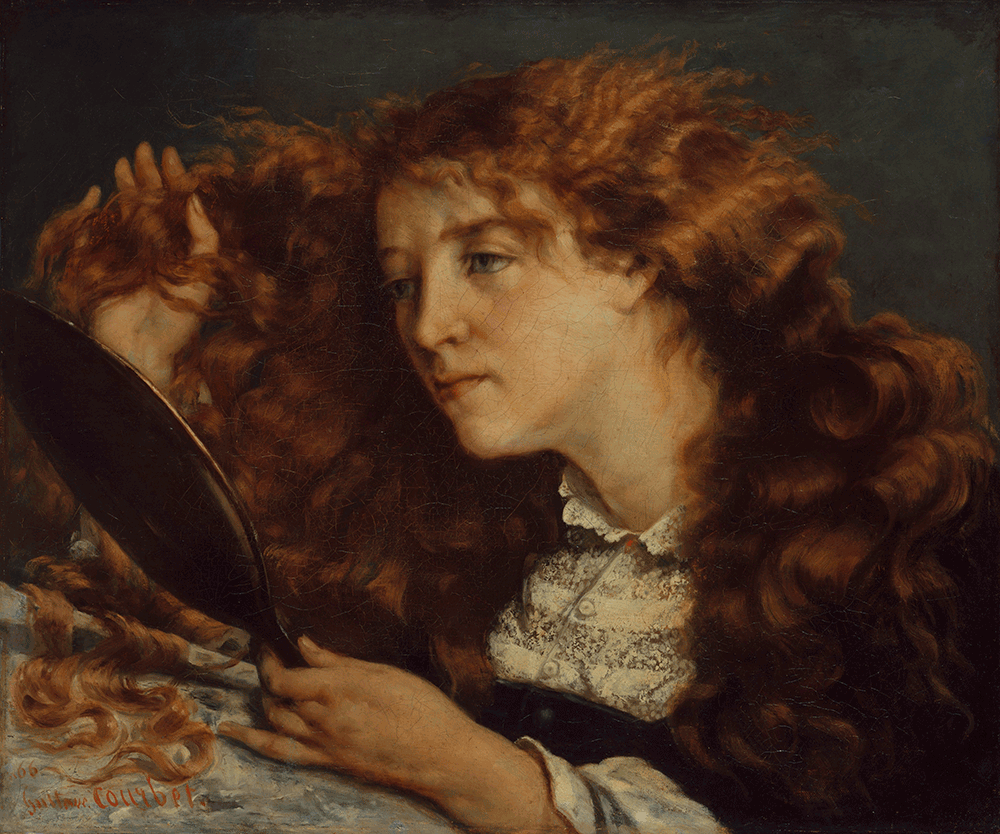 Gustave Courbet. Jo, la belle Irlandaise, 1865–1866, oil on canvas, overall: 55.9 x 66 cm (22 x 26 in.) framed: 77.5 x 88.9 x 8.3 cm (30 1/2 x 35 x 3 1/4 in.)overall: 55.9 x 66 cm (22 x 26 in.) framed: 77.5 x 88.9 x 8.3 cm (30 1/2 x 35 x 3 1/4 in.) Lent by The Metropolitan Museum of Art, H. O. Havemeyer Collection, Bequest of Mrs. H. O. Havemeyer, 1929, 29.100.63
Gustave Courbet. Jo, la belle Irlandaise, 1865–1866, oil on canvas, overall: 55.9 x 66 cm (22 x 26 in.) framed: 77.5 x 88.9 x 8.3 cm (30 1/2 x 35 x 3 1/4 in.)overall: 55.9 x 66 cm (22 x 26 in.) framed: 77.5 x 88.9 x 8.3 cm (30 1/2 x 35 x 3 1/4 in.) Lent by The Metropolitan Museum of Art, H. O. Havemeyer Collection, Bequest of Mrs. H. O. Havemeyer, 1929, 29.100.63
The intriguing “Woman in White” has inspired artists
from Victorian times to the present day
A Somnambulist
by John Everett Millais
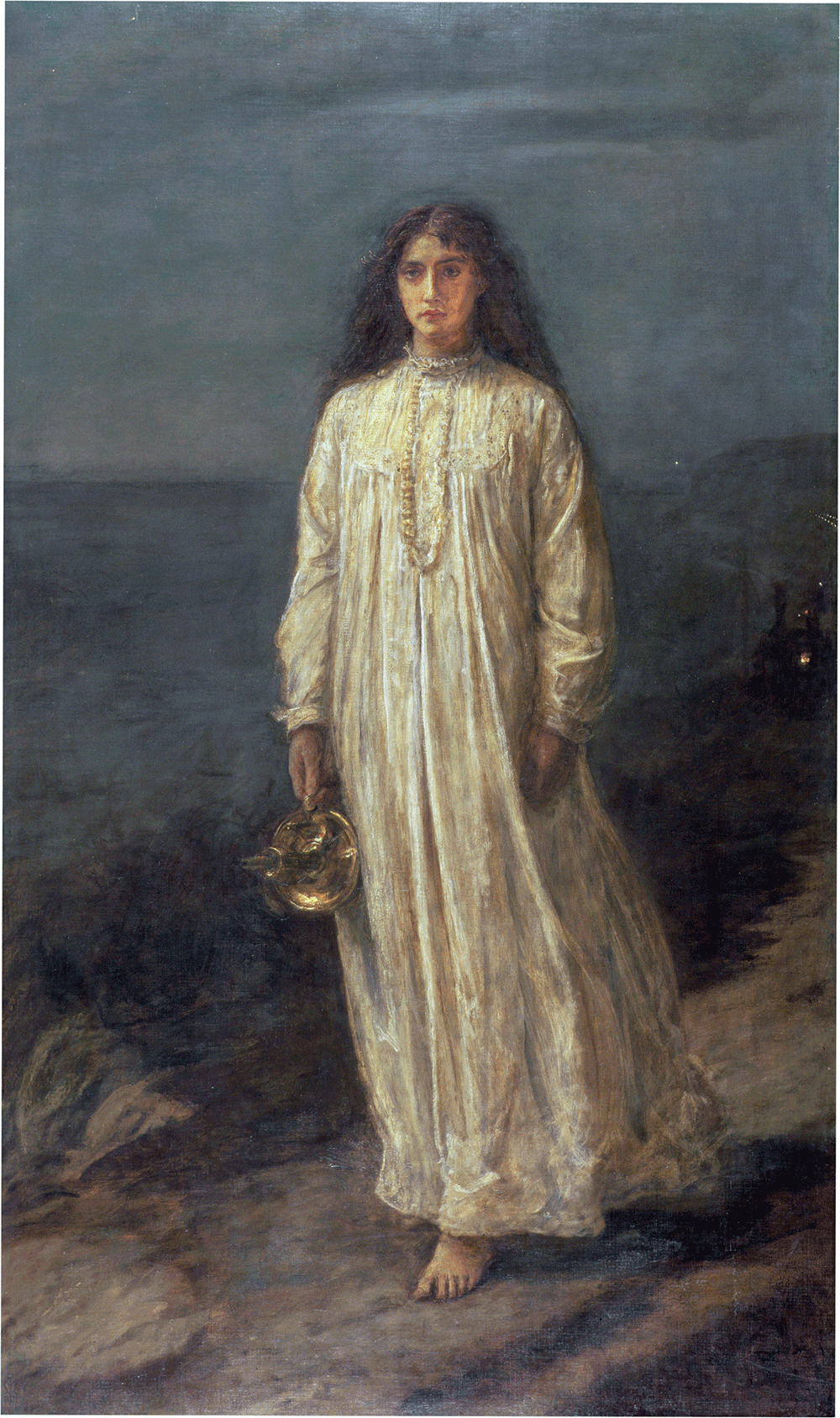
John Everett Millais. A Somnambulist, 1871, oil on canvas, overall: 154 x 91 cm (60 5/8 x 35 13/16 in.) framed: 166.4 x 104.8 x 7 cm (65 1/2 x 41 1/4 x 2 3/4 in.)overall: 154 x 91 cm (60 5/8 x 35 13/16 in.) framed: 166.4 x 104.8 x 7 cm (65 1/2 x 41 1/4 x 2 3/4 in.) Private Collection, Delaware, Courtesy of the Delaware Art Museum, Wilmington. Bridgeman Images
The Woman in White
by Frederick Walker
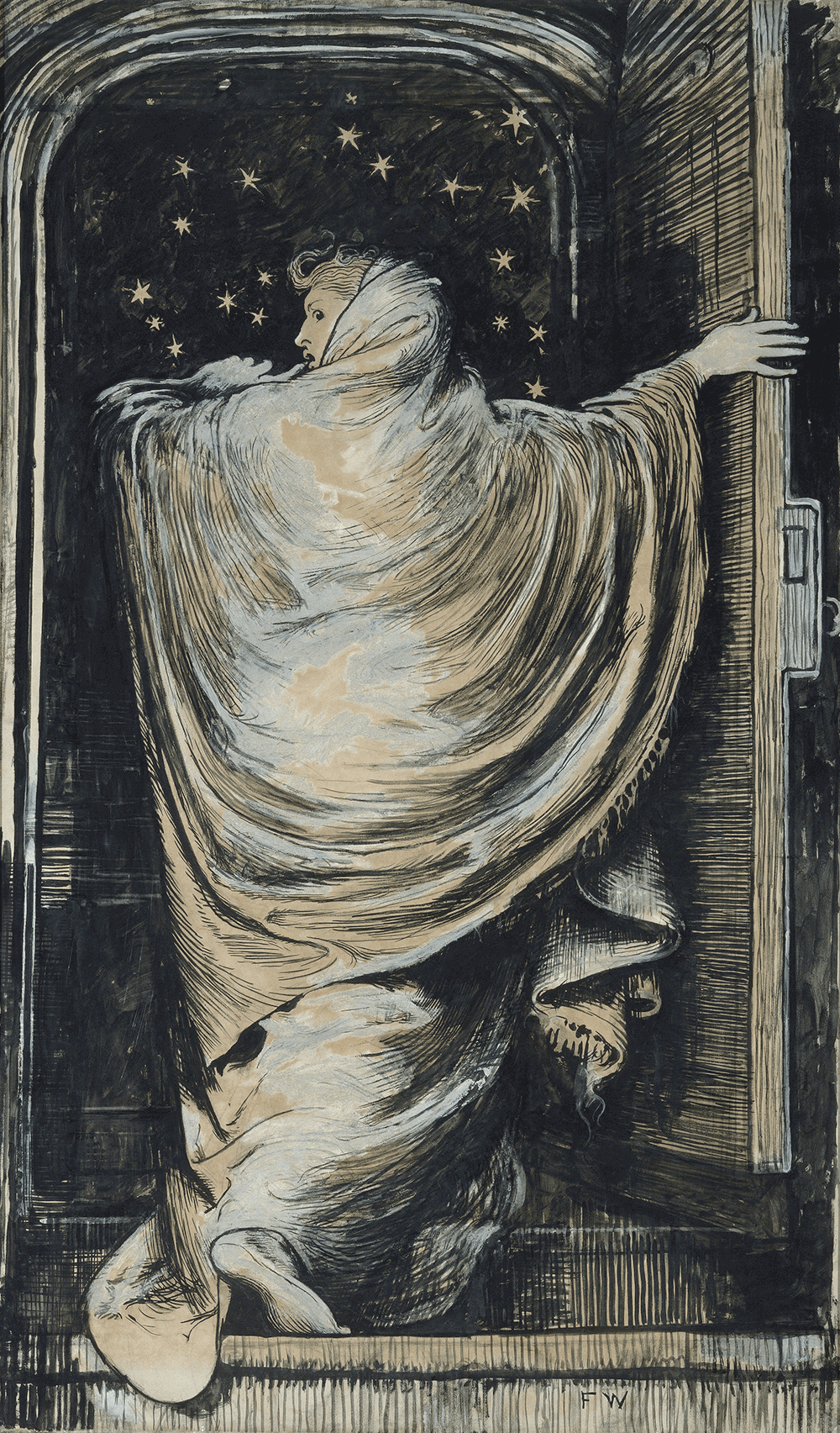 Frederick Walker. The Woman in White, 1871, gouache on paper, overall: 217.2 x 128.9 cm (85 1/2 x 50 3/4 in.) framed: 241.5 x 154 x 8 cm (95 1/16 x 60 5/8 x 3 1/8 in.)overall: 217.2 x 128.9 cm (85 1/2 x 50 3/4 in.) framed: 241.5 x 154 x 8 cm (95 1/16 x 60 5/8 x 3 1/8 in.) Tate, London, Presented by Sir Claude Phillips in memory of his sister Eugenie Phillips 1906 © Tate, London 2017
Frederick Walker. The Woman in White, 1871, gouache on paper, overall: 217.2 x 128.9 cm (85 1/2 x 50 3/4 in.) framed: 241.5 x 154 x 8 cm (95 1/16 x 60 5/8 x 3 1/8 in.)overall: 217.2 x 128.9 cm (85 1/2 x 50 3/4 in.) framed: 241.5 x 154 x 8 cm (95 1/16 x 60 5/8 x 3 1/8 in.) Tate, London, Presented by Sir Claude Phillips in memory of his sister Eugenie Phillips 1906 © Tate, London 2017
Fumée d’ambre gris
by John Singer Sargent
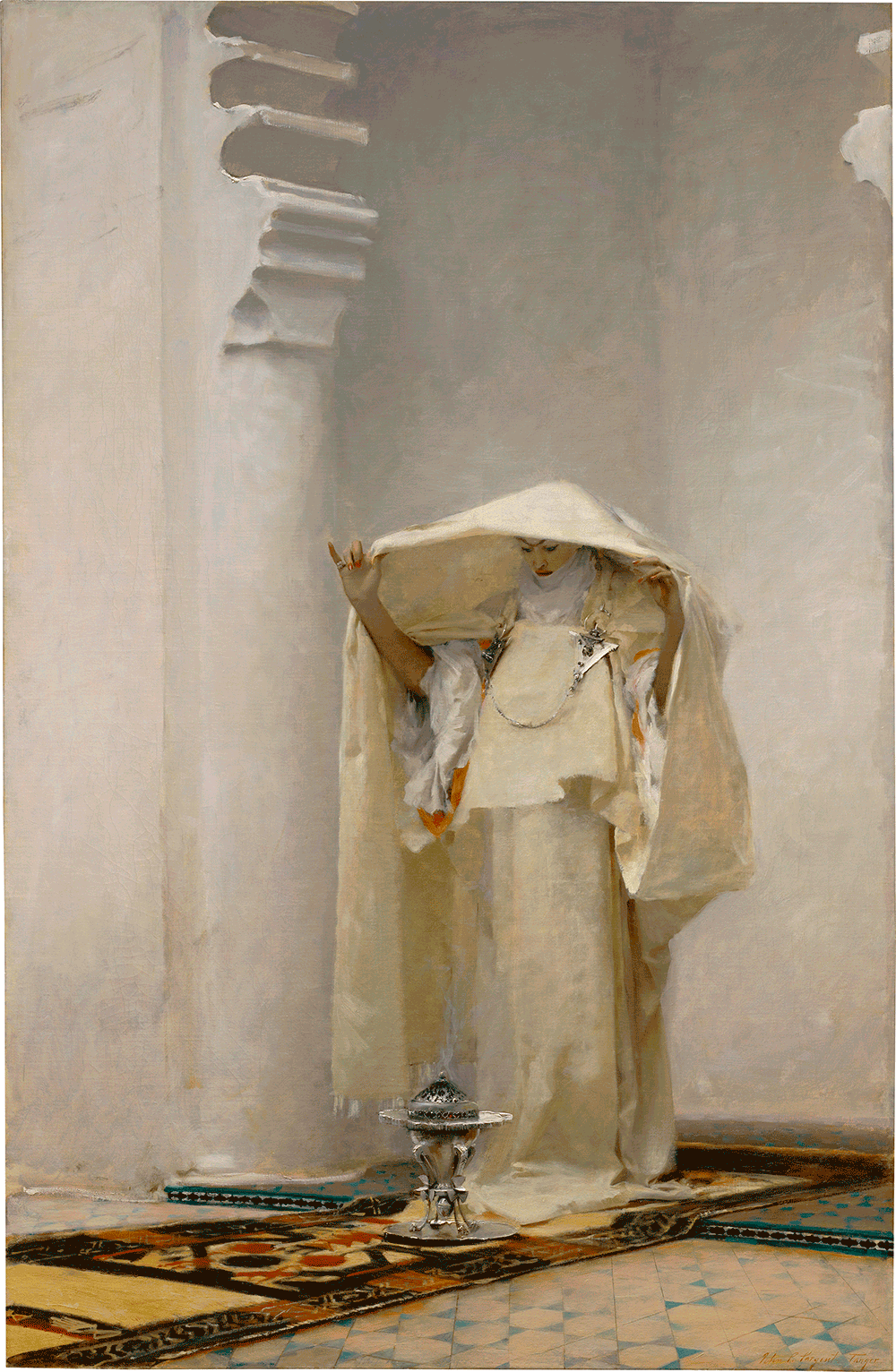 John Singer Sargent. Fumée d’ambre gris, 1880, oil on canvas, overall: 139.1 x 90.6 cm (54 3/4 x 35 11/16 in.) framed: 163.8 x 115.6 x 7.6 cm (64 1/2 x 45 1/2 x 3 in.)overall: 139.1 x 90.6 cm (54 3/4 x 35 11/16 in.) framed: 163.8 x 115.6 x 7.6 cm (64 1/2 x 45 1/2 x 3 in.) Sterling and Francine Clark Art Institute, Williamstown, Massachusetts. Image courtesy Clark Art Institute. clarkart.edu
John Singer Sargent. Fumée d’ambre gris, 1880, oil on canvas, overall: 139.1 x 90.6 cm (54 3/4 x 35 11/16 in.) framed: 163.8 x 115.6 x 7.6 cm (64 1/2 x 45 1/2 x 3 in.)overall: 139.1 x 90.6 cm (54 3/4 x 35 11/16 in.) framed: 163.8 x 115.6 x 7.6 cm (64 1/2 x 45 1/2 x 3 in.) Sterling and Francine Clark Art Institute, Williamstown, Massachusetts. Image courtesy Clark Art Institute. clarkart.edu
Detail of Jo’s Fumée d’ambre gris
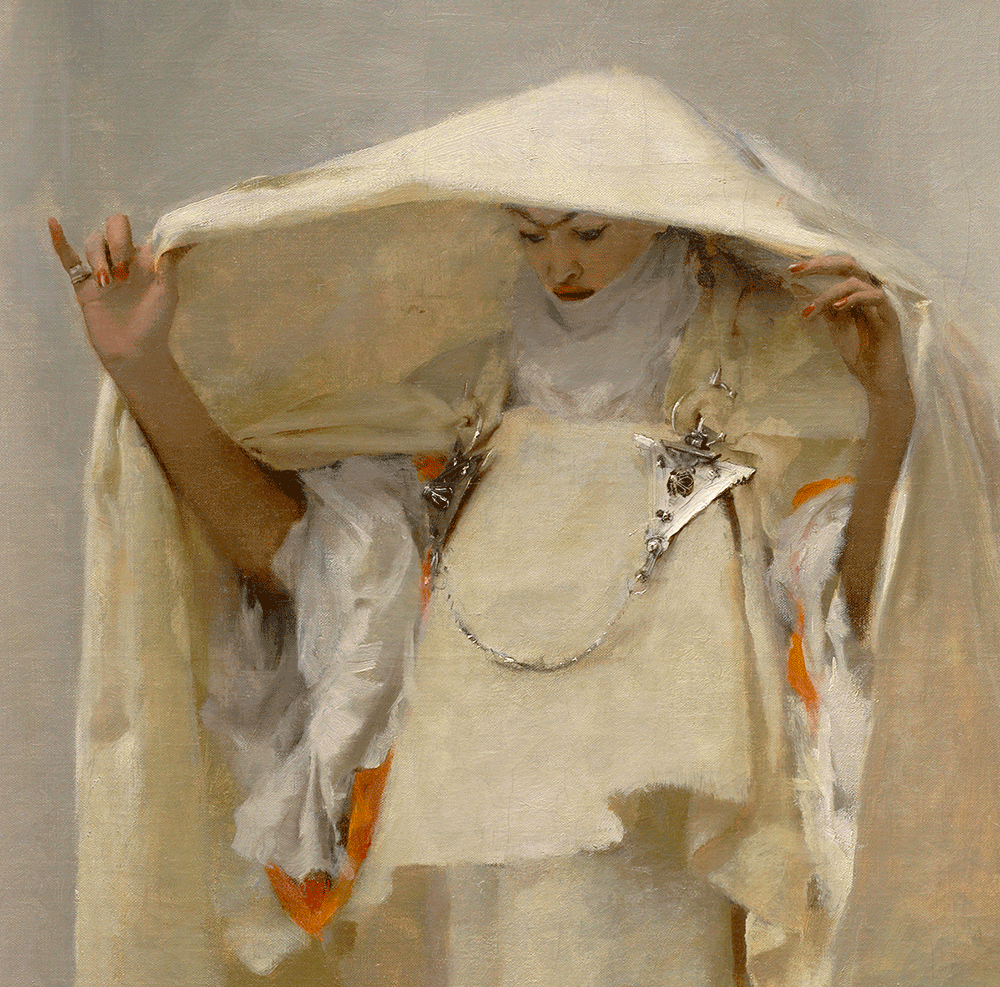
Portrait of Madeleine Mabille
by Fernand Khnopff
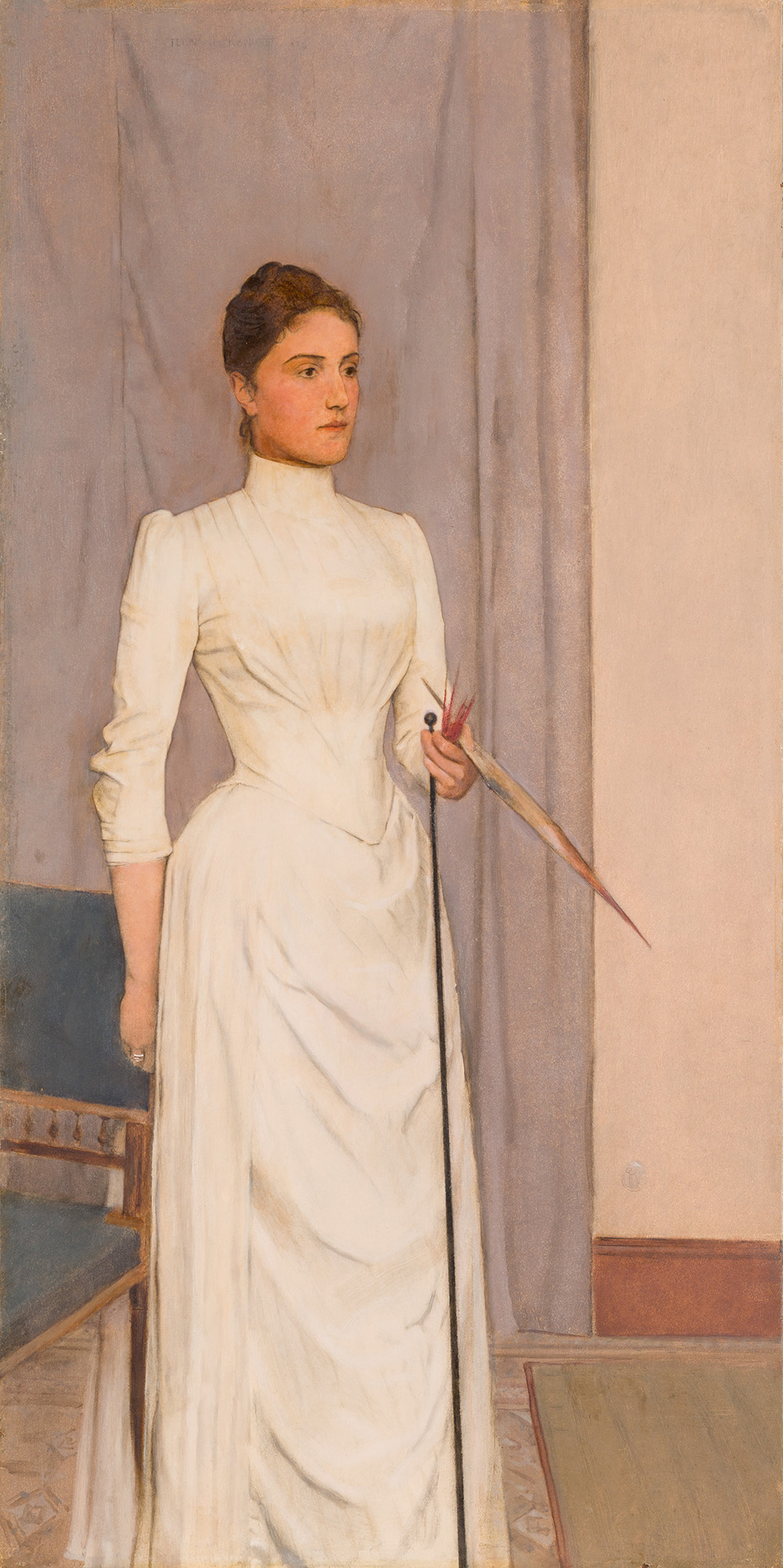 Fernand Khnopff. Portrait of Madeleine Mabille, 1888, oil with pencil on mahogany panel, overall: 69.9 x 34.3 cm (27 1/2 x 13 1/2 in.) framed: 108.3 x 67.6 x 3.8 cm (42 5/8 x 26 5/8 x 1 1/2 in.)overall: 69.9 x 34.3 cm (27 1/2 x 13 1/2 in.) framed: 108.3 x 67.6 x 3.8 cm (42 5/8 x 26 5/8 x 1 1/2 in.) Carnegie Museum of Art, Pittsburgh, Heinz Family Acquisition Fund, 93.120. Photograph © 2020 Carnegie Museum of Art, Pittsburgh
Fernand Khnopff. Portrait of Madeleine Mabille, 1888, oil with pencil on mahogany panel, overall: 69.9 x 34.3 cm (27 1/2 x 13 1/2 in.) framed: 108.3 x 67.6 x 3.8 cm (42 5/8 x 26 5/8 x 1 1/2 in.)overall: 69.9 x 34.3 cm (27 1/2 x 13 1/2 in.) framed: 108.3 x 67.6 x 3.8 cm (42 5/8 x 26 5/8 x 1 1/2 in.) Carnegie Museum of Art, Pittsburgh, Heinz Family Acquisition Fund, 93.120. Photograph © 2020 Carnegie Museum of Art, Pittsburgh
Portrait of Bessie (Miss Elizabeth Newton)
by Albert Herter
 Albert Herter, Portrait of Bessie (Miss Elizabeth Newton), 1892, oil on canvas, overall: 149.9 x 81.3 cm (59 x 32 in.) framed: 198.1 x 129.5 x 6.5 cm (78 x 51 x 2 9/16 in.)overall: 149.9 x 81.3 cm (59 x 32 in.) framed: 198.1 x 129.5 x 6.5 cm (78 x 51 x 2 9/16 in.) High Museum of Art, Atlanta, Purchase with funds from the Margaret and Terry Stent Endowment for the Acquisition of American Art and High Museum of Art Enhancement Fund, 2000.162
Albert Herter, Portrait of Bessie (Miss Elizabeth Newton), 1892, oil on canvas, overall: 149.9 x 81.3 cm (59 x 32 in.) framed: 198.1 x 129.5 x 6.5 cm (78 x 51 x 2 9/16 in.)overall: 149.9 x 81.3 cm (59 x 32 in.) framed: 198.1 x 129.5 x 6.5 cm (78 x 51 x 2 9/16 in.) High Museum of Art, Atlanta, Purchase with funds from the Margaret and Terry Stent Endowment for the Acquisition of American Art and High Museum of Art Enhancement Fund, 2000.162
Symphonie en blanc
Andrée Karpelès
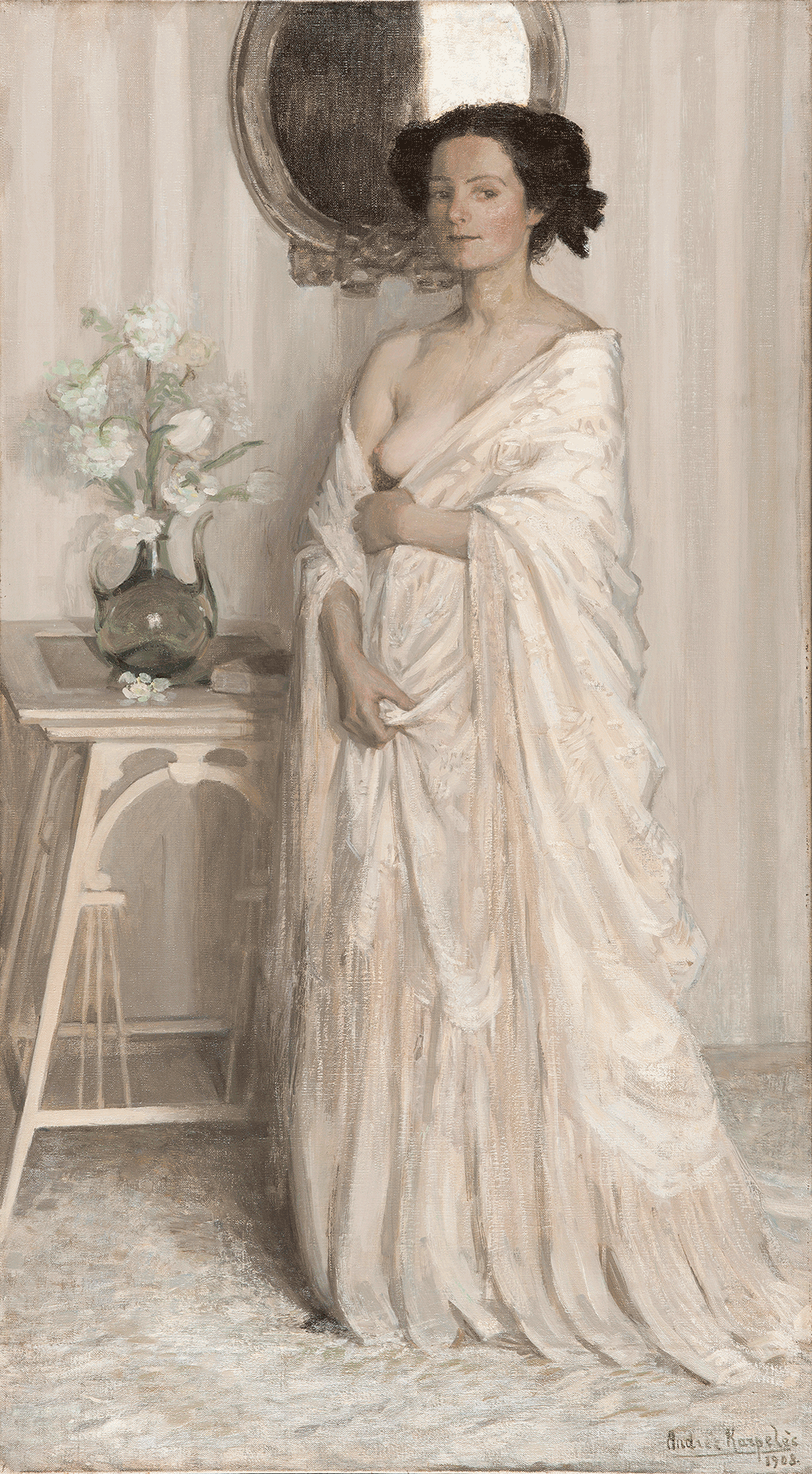 Andrée Karpelès. Symphonie en blanc, 1908, oil on canvas, overall: 142.5 x 79.7 cm (56 1/8 x 31 3/8 in.) framed: 158.8 x 96 x 9 cm (62 1/2 x 37 13/16 x 3 9/16 in.)overall: 142.5 x 79.7 cm (56 1/8 x 31 3/8 in.) framed: 158.8 x 96 x 9 cm (62 1/2 x 37 13/16 x 3 9/16 in.) Musée d’Arts de Nantes Cécile Clos / Musée d’Arts de Nantes, © rights reserved
Andrée Karpelès. Symphonie en blanc, 1908, oil on canvas, overall: 142.5 x 79.7 cm (56 1/8 x 31 3/8 in.) framed: 158.8 x 96 x 9 cm (62 1/2 x 37 13/16 x 3 9/16 in.)overall: 142.5 x 79.7 cm (56 1/8 x 31 3/8 in.) framed: 158.8 x 96 x 9 cm (62 1/2 x 37 13/16 x 3 9/16 in.) Musée d’Arts de Nantes Cécile Clos / Musée d’Arts de Nantes, © rights reserved
Hiffernan’s importance in Whistler’s art and life
In addition to being featured in nearly every major work of her early career, she helped on occasion to manage the practical tasks of the studios and residences, and in 1866 she was designated by Whistler as his sole heir and granted power of attorney. Although never married in the conventional and strictly legal sense of the term, Hiffernan and Whistler remained an integral part of each other’s lives until her death in 1886.
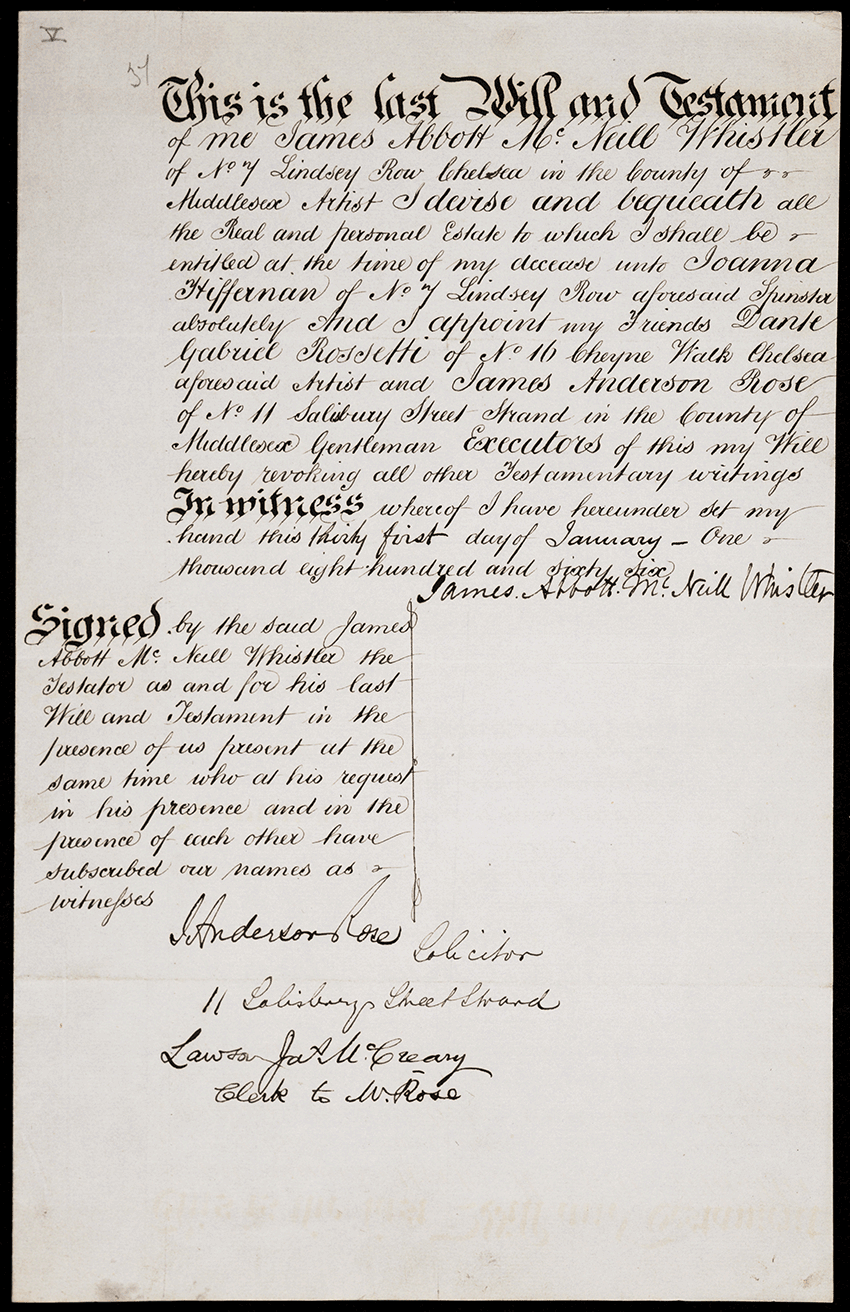
Whistler’s will, January 31, 1866, overall: 32.1 x 20.3 cm (12 5/8 x 8 in.)overall: 32.1 x 20.3 cm (12 5/8 x 8 in.) Pennell-Whistler Collection, Manuscript Division, Library of Congress, Washington, DC
 Whistler’s power of attorney, January 31, 1866, overall: 38.7 x 24.8 cm (15 1/4 x 9 3/4 in.)overall: 38.7 x 24.8 cm (15 1/4 x 9 3/4 in.) Pennell-Whistler Collection, Manuscript Division, Library of Congress, Washington, DC
Whistler’s power of attorney, January 31, 1866, overall: 38.7 x 24.8 cm (15 1/4 x 9 3/4 in.)overall: 38.7 x 24.8 cm (15 1/4 x 9 3/4 in.) Pennell-Whistler Collection, Manuscript Division, Library of Congress, Washington, DC
Vindication of the role of the model
As curator Margaret F. MacDonald rightly proposes, the creation of an iconic work of art is not only the responsibility of the artist, the model actively participates by interpreting, suggesting or stimulating the artist’s creativity. Without this involvement of the model, exceptional works of art cannot be achieved. The most famous couturiers have always recognized the inspiration suggested by their favorite mannequins. And the value of the model is also recognized by fashion photographers. So, welcome this exhibition for the recognition of the female role in art.
 Kaywin Feldman
Kaywin Feldman
Director of the National Gallery of Art
“This is the first exhibition to delve deeply into how these exquisite depictions of Joanna Hiffernan were made, what they mean, who Hiffernan was, as well as the broader influence and resonance of Hiffernan’s collaboration with Whistler for Victorian culture in the late 19th century,”
“We are deeply grateful to Professor Margaret F. MacDonald, the preeminent authority on Whistler’s art and life, for graciously agreeing to guest curate this presentation in collaboration with Ann Dumas and Charles Brock. I would like to extend our thanks to our lenders for their willingness to share their treasured works of art and to the Terra Foundation for American Art for their support of the exhibition and its accompanying book.”
Catalogue
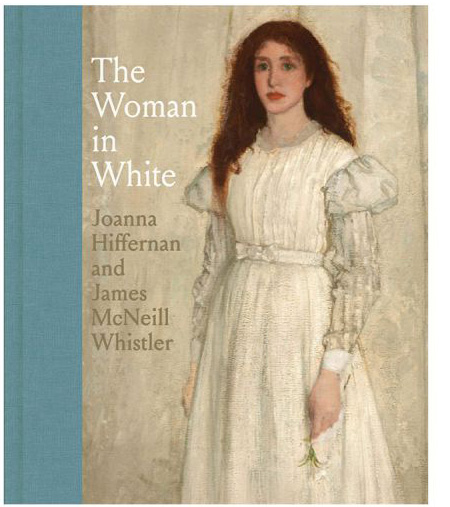 Author: Margaret F. MacDonald
Author: Margaret F. MacDonald
with contributions by
Charles Brock
Patricia de Montfort
Joanna Dunn
Grischka Petri
Aileen Ribeiro
Joyce H. Townsend
Hardcover
8.75 x 10.5 inches
232 pages, 170 color illustrations
Published 2020
$50.00
National Gallery of Art, Washington
Royal Academy of Arts, London
Yale University Press,
New Haven and London
Accompanying the National Gallery of Art exhibition The Woman in White: Joanna Hiffernan and James McNeill Whistler, this catalog offers a fascinating look at the partnership of artist James McNeill Whistler and his chief model, Joanna Hiffernan, and the iconic works of art resulting from their life together.